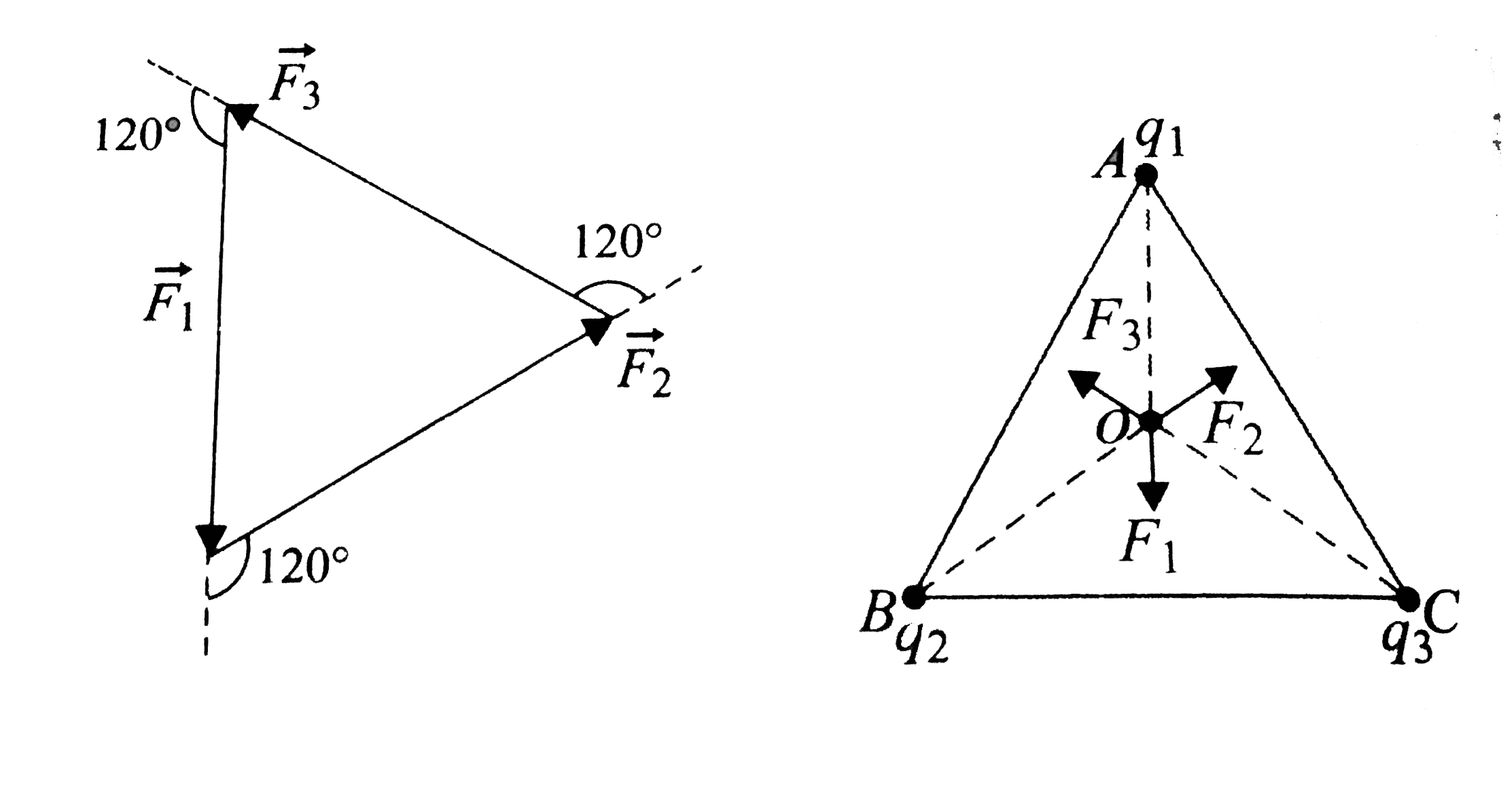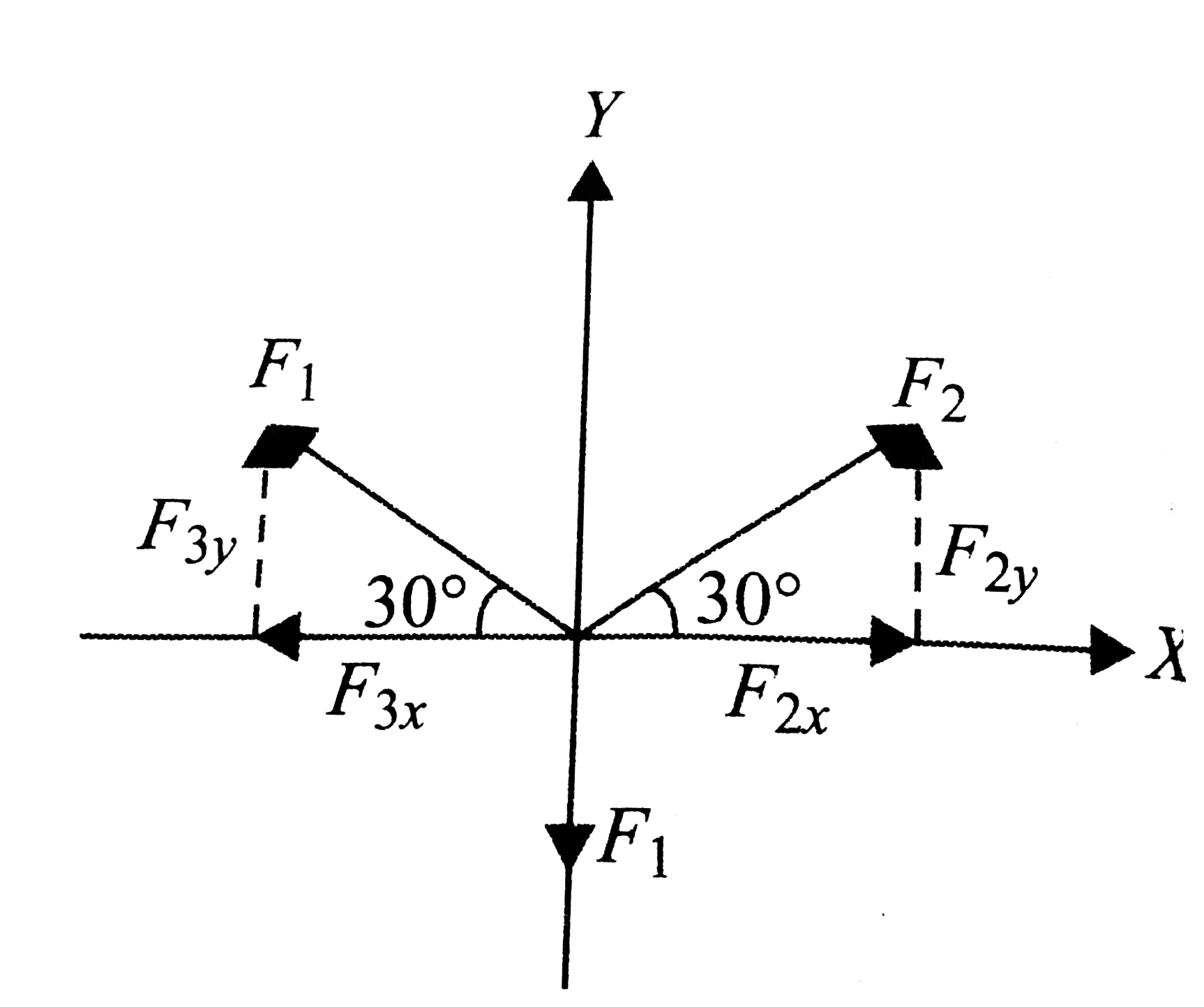Three charges of equal magnitude q is placed at the vertices of an equilateral triangle of side l. The force on a charge Q placed at the centroid of the triangle is
Method 1: The resultant of three equal coplanar vectors acting at a point will be zero if these vectors forn a closed polygon. Hence, the vector sum of the forces →F1,→F2, and →F3 is zero.
Method 2: The force action on the charge Q are
→F1= force on Q due to q1=14πε0Qq1AO2ˆAO
→F2 = force on Q due to q2=14πε0Qq2BO2ˆBO
 ,
, 
→F3= force on Q due to q3=14πε0Qq3CO2ˆCO
the resulant force is
→FR=→F1+→F2+→F3
14πε0QqAO2(ˆAO+ˆBO+ˆCO)=0
(as|q1|=|q2|=|q3| and ∣∣∣−−→AO∣∣∣=∣∣∣−−→BO∣∣∣=∣∣∣−−→CO∣∣∣
Also, −−→AO+−−→BO+−−→CO=0 because these are three equal vectors in a plane making angles of 120∘ with each other.
Method 3: The resulatant force ∑→F is the vector sum of individual force i.e.
∑→F=→F1+→F2+→F3
∴∑Fx=F1x+F2x+F3x
=0+F2cos30∘ ...(i)
and ∑Fy=F1y+F2y+F3y
=−F1+F2sin30∘+F3sin30∘ ...(ii)
As |F1|=|F2|=|F3|=|F| (say) Eqs.(i) and (ii) become
∑Fx=0 and ∑Fy=0. Hence resultant force ∑→F=0
Topper's Solved these Questions
- COULOMB LAW AND ELECTRIC FIELDBOOK - CENGAGE PHYSICS ENGLISHCHAPTER - COULOMB LAW AND ELECTRIC FIELDEXERCISE - Solved examples
10 Videos
- COULOMB LAW AND ELECTRIC FIELDBOOK - CENGAGE PHYSICS ENGLISHCHAPTER - COULOMB LAW AND ELECTRIC FIELDEXERCISE - Exercises
58 Videos
- CENGAGE PHYSICS DPPBOOK - CENGAGE PHYSICS ENGLISHCHAPTER - CENGAGE PHYSICS DPPEXERCISE - subjective type
51 Videos
- ELECTRIC CURRENT & CIRCUITSBOOK - CENGAGE PHYSICS ENGLISHCHAPTER - ELECTRIC CURRENT & CIRCUITSEXERCISE - Kirchhoff s law and simple circuits
15 Videos
Similar Questions
Three charges of equal magnitude q is placed at the vertices of an equilateral triangle of side l. The force on a charge Q placed at the centroid of the triangle is
View SolutionThree charges of equal magnitude q is placed at the vertices of an equilateral triangle of side l. The force on a charge Q placed at the centroid of the triangle is
View Solution
Knowledge Check
Consider three charges q1,q2 and q3 each equal to q, at the vertices of an equilateral triangle of side l. What is the force on a charge Q placed at the centroid of the triangle?
A3Qq4πε0l2B2Qq4πε0l2CQq2πε0l2DzeroConsider the charges q,q and -q placed at the vertices of an equilateral triangle of each side l. What is the force on each charge ?
Aq24√2πε0l2B−q24πε0l2Cq24πε0l2DzeroThree masses each of mass m are palced at the vertices of an equilateral triangles ABC of side l as shown in figure. The force acting on a mass 2m placed at the centroid O of the triangle is
 AzeroB3Gm2l2C5Gm2l2D7Gm2l2
AzeroB3Gm2l2C5Gm2l2D7Gm2l2
Three equal masses 2m each are placed at the vertices an equilateral triangle PQR
(i) What is the force acting on a mass m placed at the centroid G of the triangle ?
(ii) What is the force on mass m if the mass at the vertex P is quadrupled ?
Take PG = QG = RG = 1m

View SolutionThree positive charges of equal magnitude q are placed at the vertics of and equilatral triangle of side l. How can the system of charges be palced in equilibrium?
View SolutionThree charges each of value q are placed at the corners of an equilateral triangle. A fourth charge Q is placed at the center of the triangle.
a. Find the net force on charge q.
b. If Q=−q, will the charges at the corners move toward the center or fly away from it ?
c. For what value of Q at O will the charges remain stationary ?
d. In situation (c), how much work is done in removing the charges to infinity?
View SolutionThree point masses m,m and 2m are placed on the vertex of an equilateral triangle of side 'a' Another point mass 'm' is placed at the centroid of the triangle as shown in the figure. If the magnitude of net force on the point mass placed at centroid is KGm2a2 then find the value of K (G= universal gravitational constant )

View SolutionThree particles of equal mass 'm' are situated at the vertices of an equilateral triangle of side L. The work done in increasing the side of the triangle to 2L is
View Solution
